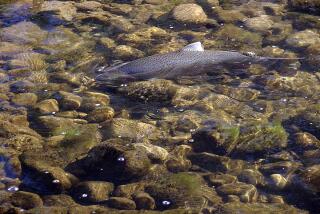Grocer Facing Charges Over Snakehead
- Share via
In a case of ethnic customs clashing with environmental protection, a Koreatown grocer is facing felony charges for selling live snakehead fish at his supermarket.
The fish, native to China but now farmed across Asia, is considered a delicacy. It is smuggled across the Pacific Ocean and sold for $15 a pound. Korean tradition holds that stewing a live fish and drinking the broth provides a medicinal boost -- especially for women recovering from childbirth.
But these fish are far from your ordinary seafood fare. The toothy, wiggling, aquatic invaders have a voracious appetite, scoot on land to get from one body of water to another, and devour so many smaller fish that they can destroy an entire ecosystem.
“All it takes is one male and one female to create disaster,” said Todd Tognazzini, warden for the California Department of Fish and Game. “If that were to start, we have no way to know where it would stop.”
Snakeheads recently took over several ponds in Maryland, alarming officials who poisoned and drained the ponds in an effort to prevent the fish from spreading. A smaller species of the fish has gotten loose in Florida.
It’s illegal to import live snakeheads into the United States for sale. But federal prosecutors said markets in heavily Korean communities find ways to sneak in the live fish.
Sung Chul “Daniel” Rhee, 46, is the first person in Southern California to face federal charges for smuggling the fish. Rhee was arrested May 14 after wildlife officials saw live snakeheads being sold at his Assi Super market on West 8th Street.
A complaint filed against Rhee by the U.S. attorney’s office last week alleges three counts of illegally importing live, injurious fish, each count carrying a maximum sentence of five years in prison. Rhee also faces eight misdemeanor counts from the Los Angeles city attorney’s office for unlawfully importing and possessing the fish.
Authorities say the fish were brought into the country hidden in large shipments of fresh seafood flown in from South Korea.
Officials said they found Styrofoam boxes containing the snakeheads that were labeled “sea bass” and marked with a bright green vertical stripe. The fish allegedly came packaged like goldfish from a pet store: half a dozen or so in a plastic bag with some ice cubes, the bag puffed up with air and secured with a rubber band.
Authorities began surveillance of Rhee’s store after receiving an anonymous tip in April 2003 that his store was selling live snakeheads.
Rhee is scheduled to be arraigned June 7. His attorney, Steve Oh, would not comment.
Rhee reportedly sold the fish at Assi Super market only on weekends. Authorities estimate that he imported at least 1,500 pounds of live snakeheads during 2002 and the first half of 2003, grossing about $23,000.
“We want to use this case not only to punish but also hold him up as a deterrent example,” said Assistant U.S. Atty. Joseph O. Johns. “Nobody’s judging a cultural practice; we’re just asking people in communities not to encourage markets to import live, injurious snakeheads.”
Two years ago, Rhee’s nephew, who owns a Korean market in Garden Grove, was caught selling live snakeheads, prosecutors said. He told wildlife officials the fish had come from Rhee’s store, according to court records. The nephew was issued a citation by a state Fish and Game warden for unlawful possession of live snakeheads, according to the documents.
Though authorities have not been able to establish a connection between the appearance of live snakeheads in Los Angeles and those in Maryland, Johns said government agencies are looking closely at an Assi seafood market owned by Rhee’s brother in Baltimore.
Among the older generations in Los Angeles’ large Korean community, snakeheads are highly regarded for their perceived healing qualities.
Ho Lee, 44, ate three snakeheads two years ago when she was pregnant with her second child. Because she had a difficult time giving birth, her aunt went to Assi Super market and bought three live fish, she said.
They boiled them into a soup, adding sesame oil and ginger to kill the fishy smell. For two weeks, she drank a bowl of it three times a day. Lee said it’s a tradition she learned from her mother, who learned from her mother.
“I felt stronger recovering,” Lee said. “The fish helped, I believe.”
She said she would no longer try to buy the fish, knowing that it is an illegal species. “In some countries they eat monkey brains; some others eat snails or horse,” she said. “It’s a difference of customs.”
The fish, which resembles a cross between an eel and a snake, will eat anything that fits into its large mouth: other fish, crustaceans, frogs, even birds and mammals. The fish are particularly damaging in a new environment like the United States, where wildlife has not evolved to defend against them.
“It’s a large predator with a big mouth that can eat a lot of things, and sometimes those are things people care about,” said Kevin Lafferty, a marine ecologist for the U.S. Geological Survey.
Snakeheads are perhaps named for their elongated bodies and tendency to sneak up on prey and bend themselves into an S-shape before seizing it in a sudden jerk.
The fish can survive out of water for up to three days, and moves across land in a snakelike slither.
Officials say a snakehead has been found in the wild just once in California -- four years ago in San Bernardino County’s Silverwood Lake.
More to Read
Sign up for Essential California
The most important California stories and recommendations in your inbox every morning.
You may occasionally receive promotional content from the Los Angeles Times.










